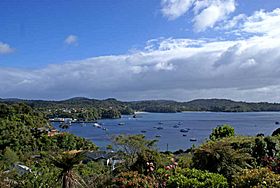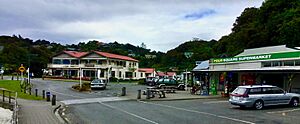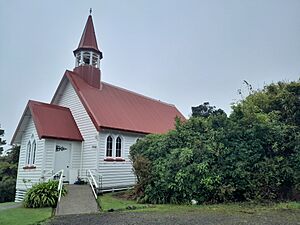Oban, New Zealand facts for kids
Quick facts for kids
Oban
Pā nui o Hau (Māori)
|
|
|---|---|
|
Town
|
|

Overlooking Oban and Halfmoon Bay
|
|
| Country | New Zealand |
| Region | Southland Region |
| Territorial authorities of New Zealand | Southland District |
| Ward | Stewart Island/Rakiura Ward |
| Community | Stewart Island/Rakiura Ward Community |
| Electorates |
|
| Area | |
| • Total | 2.59 km2 (1.00 sq mi) |
| Population
(June 2023)
|
|
| • Total | 330 |
| • Density | 127.4/km2 (330/sq mi) |
Oban is the main town on Stewart Island, which is the southernmost island where people live in New Zealand. It's located around Halfmoon Bay and reaches towards Paterson Inlet. You can get to Oban by plane from Invercargill or by ferry from Bluff, both on New Zealand's South Island.
The town was named after Oban in Scotland. The Scottish name An t-Òban means The Little Bay. This name was chosen because many Scottish settlers came to southern New Zealand a long time ago.
Tourism has grown a lot since the Rakiura National Park opened. This has brought more business and government money to the island.
Contents
People Living in Oban
Oban is a small rural town. It covers about 2.59 square kilometers. In 2018, about 300 people lived there. This means there were about 116 people for every square kilometer. Oban is part of the larger Stewart Island area.
| Historical population | ||
|---|---|---|
| Year | Pop. | ±% p.a. |
| 2006 | 291 | — |
| 2013 | 273 | −0.91% |
| 2018 | 300 | +1.90% |
At the 2018 New Zealand census, Oban had 300 residents. This was an increase of 27 people since 2013. There were 165 homes. There were more males (156) than females (144).
About 11% of the people were under 15 years old. Most people (48%) were between 30 and 64 years old. About 23% were 65 or older.
Most people (92%) were of European background. About 19% were Māori. A small number of people were from Pasifika, Asian, or other backgrounds. Some people identified with more than one ethnicity.
When asked about religion, 65% said they had no religion. About 26% were Christian. A small number were Buddhist or had other religions.
Many adults in Oban had a university degree (24.7%). About 16.9% had no formal qualifications. Most adults (56.2%) worked full-time.
Oban's Weather
Oban has an oceanic climate. This means temperatures are mild to cool all year. The warmest month is January, with average high temperatures around 17.6°C. The coolest month is July, with average highs around 10.1°C.
The ocean keeps the temperatures from changing too much. The difference between day and night temperatures is small. The difference between summer and winter temperatures is also small.
It rains a lot in Oban, about 1490 millimeters per year. The rain is spread out evenly throughout the year. Oban is often windy, cloudy, and rainy. This is because it is in the path of weather systems coming from the Southern Ocean. Sunny days with little wind are not common.
| Climate data for Oban, Stewart Island (1991–2020 normals, extremes 1975–present) | |||||||||||||
|---|---|---|---|---|---|---|---|---|---|---|---|---|---|
| Month | Jan | Feb | Mar | Apr | May | Jun | Jul | Aug | Sep | Oct | Nov | Dec | Year |
| Record high °C (°F) | 30.6 (87.1) |
28.5 (83.3) |
26.5 (79.7) |
29.0 (84.2) |
20.5 (68.9) |
17.5 (63.5) |
16.0 (60.8) |
17.1 (62.8) |
21.3 (70.3) |
25.0 (77.0) |
26.5 (79.7) |
28.5 (83.3) |
30.6 (87.1) |
| Mean daily maximum °C (°F) | 17.6 (63.7) |
17.5 (63.5) |
16.2 (61.2) |
14.4 (57.9) |
12.4 (54.3) |
10.4 (50.7) |
10.1 (50.2) |
10.8 (51.4) |
12.5 (54.5) |
13.6 (56.5) |
14.9 (58.8) |
16.7 (62.1) |
13.9 (57.1) |
| Daily mean °C (°F) | 13.6 (56.5) |
13.5 (56.3) |
12.3 (54.1) |
10.7 (51.3) |
9.0 (48.2) |
7.0 (44.6) |
6.5 (43.7) |
7.2 (45.0) |
8.6 (47.5) |
9.7 (49.5) |
10.9 (51.6) |
12.7 (54.9) |
10.1 (50.3) |
| Mean daily minimum °C (°F) | 9.6 (49.3) |
9.5 (49.1) |
8.4 (47.1) |
7.0 (44.6) |
5.7 (42.3) |
3.6 (38.5) |
2.8 (37.0) |
3.7 (38.7) |
4.8 (40.6) |
5.7 (42.3) |
7.0 (44.6) |
8.7 (47.7) |
6.4 (43.5) |
| Record low °C (°F) | 1.0 (33.8) |
0.9 (33.6) |
0.7 (33.3) |
−0.4 (31.3) |
−6 (21) |
−7.3 (18.9) |
−6 (21) |
−7 (19) |
−4.5 (23.9) |
−1.8 (28.8) |
−0.4 (31.3) |
0.6 (33.1) |
−7.3 (18.9) |
| Average rainfall mm (inches) | 138.4 (5.45) |
106.9 (4.21) |
139.3 (5.48) |
118.7 (4.67) |
155.3 (6.11) |
139.6 (5.50) |
130.8 (5.15) |
116.0 (4.57) |
122.8 (4.83) |
146.5 (5.77) |
134.4 (5.29) |
116.3 (4.58) |
1,565 (61.61) |
| Average rainy days (≥ 1.0 mm) | 15.3 | 13.6 | 15.4 | 16.0 | 17.9 | 17.8 | 17.0 | 16.5 | 16.0 | 17.0 | 17.0 | 16.1 | 195.5 |
| Average relative humidity (%) | 84.3 | 87.4 | 87.4 | 89.4 | 91.1 | 90.9 | 91.3 | 89.9 | 85.0 | 84.3 | 81.6 | 82.6 | 85.8 |
| Source: NIWA (rainy days and humidity 1975–2015) | |||||||||||||
Native Wildlife
You can often see native kākā birds during the day in Oban. At night, you might spot kiwi birds.
People are working hard to protect these native birds. They are trying to remove animals that hunt them. These include stoats and domestic cats. There are also plans to remove possums, three types of rat, and hedgehogs.
Rakiura Museum
The Rakiura Museum first opened in 1960 in an old house. A new, special building for the museum opened in December 2020. It cost $3 million to build.
The museum shows the history of Stewart Island. You can learn about whaling and sealing, boat building, and how Māori people settled there. It also has exhibits about the island's amazing natural history.
Schools in Oban
Halfmoon Bay School / Te Kura o Rakiura teaches students from year 1 to year 8. As of 2023, it has 38 students. The school first opened its doors in 1874.
Churches in Oban
The Oban Presbyterian Church was built in 1904. Electric lights were added in 1957. It is on Kamahi Road and looks out over Halfmoon Bay. The church does not have a full-time minister, but visiting preachers lead services.
St Andrews Anglican Church is located at 10 Excelsior Road. Prince Harry visited St Andrews Church in 2015.
See also
 In Spanish: Oban (Nueva Zelanda) para niños
In Spanish: Oban (Nueva Zelanda) para niños





